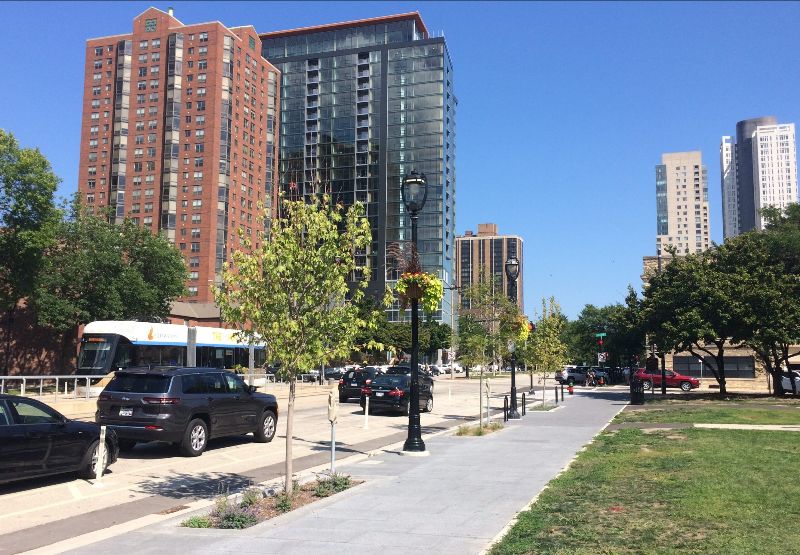City Sees 1.14% New Construction Growth
Such growth is critical for cities like Milwaukee if they hope to increase the tax levy.

Ascent, as seen from Cathedral Square, opened in Aug. 2022. Photo courtesy of Cathedral Square Friends.
Every year at this time all of Wisconsin’s 1,253 towns, 411 villages and 190 cities must assemble a budget for the upcoming year. The first step is to calculate the prior year’s adjusted levy — the total amount of taxes billed by the municipality. The second is to determine the amount of net new construction in the previous year.
This is a key figure for budget officials, for that is the amount by which the levy may be increased.
The League of Wisconsin Municipalities Municipal Budgeting Toolkit cautions:
If no new construction occurred in your community, then your allowable levy increase is zero percent.
You can see there is a big incentive for new construction. This works to the advantage of communities with ample undeveloped land, and to the detriment of older established communities where, in order to build something new, something old must be torn down. Milwaukee County has the state’s largest share of developed property. It is the only one with no town governments, which rule most of the Badger State’s fields and forests.
City Adds $450 Million in Net New Construction
According to the Department of Revenue’s 2023 Net New Construction Report of Aug. 9, the City of Milwaukee saw $449,351,000 in new construction, adding 1.14% to the previous year’s assessed valuation of $39.4 billion. Thus the city could increase its 2024 levy by 1.14% above the $311,202,826 in the 2023 budget, adding $3,547,712 to the permitted levy.
Inflation Wipes That Out — And Then Some
The next day, the U.S. Department of Labor released its quarterly Consumer Price Index Summary, which reported that inflation had increased 3.2% in the previous twelve months. That’s triple the rate of increase in new construction here. Right off the bat, the city budget would have faced an additional $7 million hole, were it not for the state granting the city the right to impose a two-percent sales tax beginning in January. (At the same time, Milwaukee County will be able to increase its sales tax from .05% to .09%.)
A Key in Budget Decisions
Since municipalities have few options to raise their taxes short of borrowing or referenda, officials pay close attention to new construction in their communities. According to City Budget Director Nik Kovac, Milwaukee’s 2023 net new construction percentage of 1.14% is “close to the 5, 10, and 14 year rolling averages of prior annual increases.” Those prior annual percentages have been as low as .65% in 2011 and as high as 1.72% in 2016.
Kovac attributed that good news on the bond rating to the new revenue sources the state has now provided – namely long-sought annual increases to shared revenue and the local sales tax. Those new sources of revenue will take some of the pressure off user fees, the property tax levy, and capital borrowing, which had been the only three big line items the City had any flexibility to increase. There is now room, Kovac says, to assemble a budget that can be sustained for years. The 2024 budget will address some accumulated deferred maintenance issues by increasing its cash-financing of several capital projects, and by switching some costs back to operating from the capital budget. “There are clearly defined capital costs, and clearly defined operating costs, but there is also a middle ground,” he says. In recent years there was so much pressure on the operating budget that some costs were shifted to capital, but that trend can now be reversed.
Milwaukee County’s Winners
The City of Milwaukee’s 1.14% increase slightly lagged that of Milwaukee County as a whole, which enjoyed a 1.26% boost due to the $1.07 billion in new construction. Of the five municipalities that topped Milwaukee’s growth, the leading community was Wauwatosa, which boosted its value by 3.05% with $274,477,700 in new construction — more than half of the City of Milwaukee’s. Other communities that outpaced the Cream City were:
- Brown Deer (2.05%)
- Franklin (1.76%)
- Oak Creek (1.58%)
- Glendale (1.31%)
Brown Deer and Glendale, long on the hunt for revenue, engaged in extensive redevelopment projects, adding commercial space and multi-family housing. Franklin and Oak Creek, which are outlying communities, had the advantage of vacant land in addition to redevelopment sites.
Yet none of these entities saw an increase that outpaced inflation. Nor do they have a sales tax.
Milwaukee County’s Laggards — and One Loser
Twelve of the county’s 19 municipalities saw their Net New Construction percentages lag those of Milwaukee. One was in negative territory.
- Bayside (-0.01%)
- Greendale (0.12%)
- St. Francis (0.16%)
- Hales Corners (0.21%)
- Shorewood (0.27%)
- Cudahy (0.29%)
- Fox Point (0.36%)
- Greenfield (0.48%)
- River Hills (0.49%)
- West Milwaukee (0.54%)
- South Milwaukee (0.56%)
- West Allis (0.65%)
- Whitefish Bay (0.77%)
The list demonstrates why using a rolling average of years of new construction is advisable. Shorewood and West Allis have engaged in vigorous redevelopment plans by increasing density, as they have little, if any, open land. Since 2016, West Allis saw its taxable value increase from $3.7 billion to $5.5 billion. Shorewood’s went up from $1.5 billion to over $2 billion.
Most of the other communities have extremely limited open land — if any at all.
Take the case of Bayside, where the Net New Construction was negative. Development is now underway on OneNorth, estimated to cost about $100 million, aided by $35 million in village funding commitments. But before building could begin, a number of the community’s largest commercial buildings were razed, removing millions from the tax rolls, thus accounting for the negative value.
Consider the Village of Windsor, in booming Dane County. In 2017, it was worth $717 million. Last year’s 9.10% increase (apparently the best in the state) boosted it to $1.30 billion. A look at the map shows the land is mostly open, and that development is suburban-style housing in converted cornfields.
UPDATE: The section entitled “A Key in Budget Decisions” has been substantially updated since the article’s publication. Additionally, an earlier version cited a different number of villages.
If you think stories like this are important, become a member of Urban Milwaukee and help support real, independent journalism. Plus you get some cool added benefits.
Plenty of Horne
-
Milwaukee Modernism Gains National Awards
 Dec 15th, 2025 by Michael Horne
Dec 15th, 2025 by Michael Horne
-
New Rainbow Crosswalks Mark Milwaukee’s LGBTQ+ History
 Oct 8th, 2025 by Michael Horne
Oct 8th, 2025 by Michael Horne
-
Welcome Back, Tripoli Country Club!
 May 27th, 2025 by Michael Horne
May 27th, 2025 by Michael Horne





















